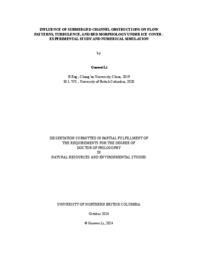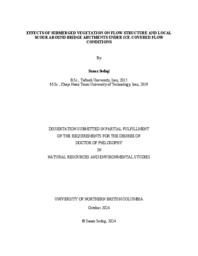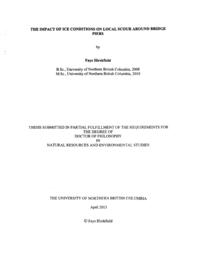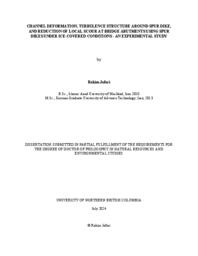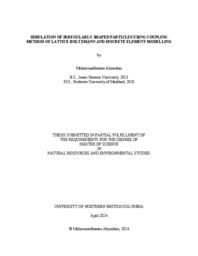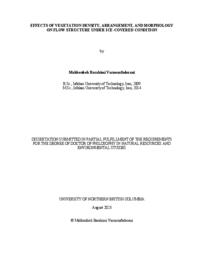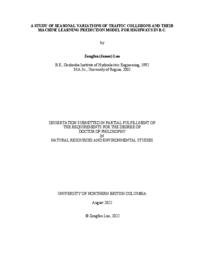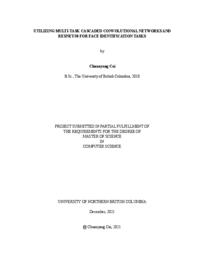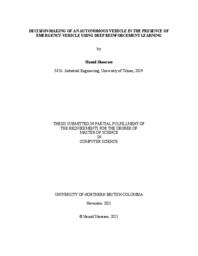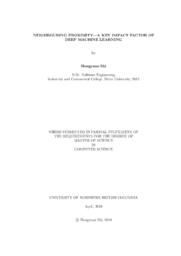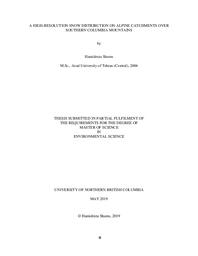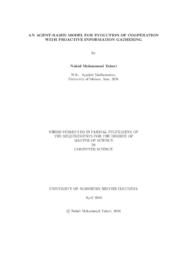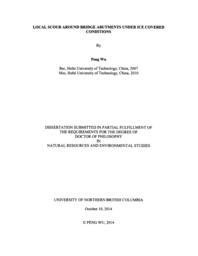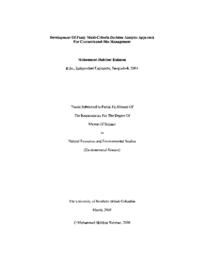Sui, Jueyi
Person Preferred Name
Jueyi Sui
Related Works
Content type
Digital Document
Origin Information
Content type
Digital Document
Origin Information
Content type
Digital Document
Origin Information
Content type
Digital Document
Origin Information
Content type
Digital Document
Origin Information
Content type
Digital Document
Description / Synopsis
In this study, the lattice Boltzmann method (LBM) and the discrete element method (DEM) are coupled to simulate the interaction between the fluid phase and irregularly shaped solid particles. For this purpose, the geometry of real particle shapes is represented as clumps of overlapping spheres and then simulated through a multi-sphere model in DEM and coupled with LBM using two open-access codes, LIGGGHTS and Palabos. The accuracy of the coupling method with clumps is demonstrated by simulating several benchmark cases and comparing them with the results from the literature. The coupled LBM-DEM method is then used to simulate the collapse and transport of submerged granular particles with four different irregular particle shapes in addition to sphere particle shapes to highlight the influence of grain morphology in the solidfluid interaction. To the authors’ best knowledge, it is the first time that LIGGGHTS and Palabos were used to simulate the LBM-DEM coupling of irregular particles. This study demonstrates the potential and accuracy of LBM-DEM method in simulating particles with irregular shapes. The research also provides insight into the importance of considering real shape particles in simulating granular flows in geotechnical engineering.
Origin Information
Content type
Digital Document
Description / Synopsis
Aquatic vegetation appears very often in rivers and floodplains, which significantly affects the flow structure. On the other hand, a common feature of cold regions is the presence of river ice on water surfaces. Ice cover imposes an additional boundary layer on water surface which leads to significant change in flow structure and bed deformation. It also causes a decreasing trend of velocity profile near the cover. Because of vegetation’s positive impacts on water quality, habitat, and channel stability, researchers now advocate replanting and restoring projects in rivers, especially in agricultural waterways, floodways, and emergency spillways. The expansion of vegetation in fluvial systems may worsen the flood impact since highly dense vegetation in a channel reduces its flow capacity due to the increase in flow resistance and decrease in the channel width. Therefore, an accurate and critical assessment of the vegetation density and distribution pattern through reduction of bulk velocity is crucial in sustainable restoration projects. To the author's knowledge, no studies have been conducted to investigate the impacts of both ice cover and vegetation on flow resistance and channel bed deformation. It is thus necessary to examine the connection between vegetation and ice covers thoroughly in order to guarantee successful restoration projects. Most of research projects on submerged vegetation have been done in small-scale laboratory flume and specifically under the open channel flow condition. Besides, most of reported research uses uniform sediment which is not an appropriate representative of natural river systems. In the present study, deflected and non-bending model vegetation elements arranged in both square and staggered configurations with different density in the channel bed with three different non-uniform sands under different cover conditions of water surface including open channel flow and ice-covered flow conditions were used. In order to simulate the ice cover condition, smooth and rough ice covers made of Styrofoam panels were created to investigate the impacts of ice cover roughness on channel bed deformation. To represent non-uniform sediment condition, three different bed materials with median particle size (D50) of 0.50 mm, 0.60 mm, 0.98 mm were used. Results showed that the most significant variable influencing the depth of scour holes under ice-covered flow conditions is the ratio of the ice cover roughness to the bed roughness and in open channel flow conditions, the flow Froude number is determining. In the conducted experiments, it was consistently observed that the maximum scour depths occurred at the upstream, front face of the vegetation elements. It was found that the scour holes were deeper and longer under ice-covered flow. In the presence of vegetation in the bed under ice-covered flow conditions, the velocity profiles exhibit a distinct pattern characterized by two peak values. The study revealed an inverse relationship between canopy density and the dimensions of the wake zone. As the spacing distance between deflected vegetation elements decreases, the streamwise velocity experiences significant retardation slightly below the inflection point. With a sparser vegetation canopy, the inflectional region tends to diminish or disappear. Furthermore, the study observed that the inflection point was not observed in non-bending vegetation. Additionally, velocity profiles showed more pronounced inflection points in the case of a staggered arrangement of vegetation elements compared to a square arrangement. Results of this study will provide vital information for river management, channel restoration, and rehabilitation of fluvial environments through understanding the effect of various vegetation densities, arrangement patterns and morphology, as well as the revitalization of cold-weather river ecosystems.
Origin Information
Content type
Digital Document
Description / Synopsis
Traffic collisions are considered as one of the world’s major public health problems. According to the World Health Organization (WHO), about 1.3 million people die every year in traffic collisions across the world and a further 20 - 50 million are injured or disabled. Various tools/methods were developed to assess highway safety. Historically, collision frequency, collision rates, linear regression and generalized linear regression, and Bayesian modeling methods have been used as the basis for safety analysis. Research has shown that there are limitations with this approach due to the non-linear relationship between collision frequency and exposure. Traffic volume is directly related to traffic exposure, traffic exposure affects collision risk and collision risk significantly determines the probability of traffic collision occurring. The different traffic exposure has a different level of effects on collision risk, and different level of collision risk results in the different probability of collision occurring and collision severity. Collision prediction modeling (Safety Performance Function) is the recommended technique for estimating road safety in the Highway Safety Manual (HSM) by the American Association of State Highway and Transportation Officials (AASHTO). However, the prediction modeling has not taken into consideration of traffic seasonal variations, collision seasonal variations and weather impacts as the annual average daily traffic (AADT) is one of main dominant variables. Previous studies indicate that weather especially winter weather condition is significantly associated with the traffic collisions. For example, studies showed that 24% of all collisions are weather-related in United States and collision risk could increase from 50 to 100 percent during precipitation. Due to climate change, weather patterns are changing, and the frequency of extreme weather events increases, which will affect highway safety and reliability. This study synthesizes the major findings and proposed methodologies from the existing traffic safety studies. Collision risks related to weather are investigated and assessed. Traditional techniques of highway safety assessment without the consideration of seasonal variations of traffic collisions, especially winter weather condition impacts in Canada, might result in underestimating the safety risk in winter weather conditions. All predication models developed to date have not taken into consideration of traffic and collision seasonal variations, and weather condition. Machine learning (ML) is able to address non-linear relationship between traffic exposure and collision frequency, to handle multivariate data, and to improve over time in the traffic collision prediction modelling. Two major highways (Highways 16 and 97) with a total length of approximate 2,500 km within Northern Region in the Province of British Columbia, Canada, are investigated. This study has mainly focused on the seasonal variations of collisions and traffic volumes to improve the highway safety. A traffic collision prediction model integrated traffic seasonal variations and weather impacts is proposed and developed by applying machine learning (ML) techniques (neural network regression) in the study. In conclusion, the proposed model is able to predict the traffic collision seasonal variations, and to provide more accurate estimate of traffic collisions with over 90% accuracy on both rural and urban highways. The model can be used to assist in developing road safety improvement policy considering collision seasonal characteristics.
Origin Information
Content type
Digital Document
Description / Synopsis
In recent years, computer-animated characters have been designed more and more vivid and lifelike, and many of them are extremely similar to real people. Due to the high degree of similarity, some classical face recognition models are mixed up in the face identification process. For example, FaceNet model matches cartoon facial images with their similar real faces. In this case, some people may try to cheat by using virtual faces when they are identified by face recognition systems. To address this problem, this paper proposes an integrated approach that utilizes Multi-task Cascaded Convolutional Networks (MTCNN) and Resnet-50 models for the classification of real and cartoon faces (or virtual faces) of an input image before the face identification task. Our experiments show that the proposed integrated approach achieves better results on face identification tasks compared to some classical face recognition models that accomplish the tasks directly.
Origin Information
Content type
Digital Document
Description / Synopsis
Autonomous Vehicles are the future of road transportation where they can increase safety, efficiency, and productivity. In this thesis, we address a new edge case in autonomous driving when one autonomous vehicle is approached by an emergency vehicle and needs to make the best decision. To achieve the desired behavior and learn the sequence decision process, we trained our autonomous vehicle with the help of Deep Reinforcement Learning algorithms and compared the results with rule-based algorithms. The driving environment for this study was developed by using Simulation Urban Mobility as an open-source traffic simulator. The proposed solution based on Deep Reinforcement Learning has a better performance compared to the rule-based solution as a baseline both in normal driving situations and when an emergency vehicle is approaching.
Origin Information
Content type
Digital Document
Description / Synopsis
Deep Learning has become increasingly popular since 2006. It has an outstanding capability to extract and represent the features of raw data and it has been applied to many domains, such as image processing, pattern recognition, computer vision, machine translation, natural language processing, and autopilot. While the advantages of deep learning methods are widely accepted, the limitations are not well studied. This thesis studies cases where deep learning methods lose their advantages over traditional methods. Our experiments show that, when the neighbouring proximity disappears, deep learning methods are significantly less powerful than traditional methods. Our work not only clearly indicates that deep structure methods cannot fully replace traditional shallow methods but also shows the potential risks of applying deep learning to autopilot.
Origin Information
Content type
Digital Document
Description / Synopsis
Local scour around piers and abutments is one of the main causes of the collapse of many bridges constructed inside rivers. Many researchers have conducted various studies to predict the maximum depth of a scour hole around bridge piers and abutments. However, most of them have been done in small-scale laboratory flumes and specifically for the open channel condition. Besides, most of the existing research on bridge piers uses uniform sediment which is not an appropriate representative of natural river systems. This can result in excessively conservative design values for scour in low risk or non-critical hydrologic conditions. The most severe cases of bridge pier scouring occur in cold regions when the surface of water turns into ice in which, an additional boundary layer is being added to the water surface, which leads to significant changes in the flow field and scour pattern around bridge piers. Ice cover also causes the maximum flow velocity to move closer to the channel bed.
Origin Information
Content type
Digital Document
Description / Synopsis
Snow plays an important role on the hydrological cycle of watersheds in cold regions. Predicting timing and magnitude of snow accumulation and ablation is necessary for water management in different sectors. A spatially distributed snow model (SnowModel) is chosen for our research, which is forced by meteorological data provided from automated weather stations. SnowModel is evaluated for two watersheds in southeast of BC. Two consecutive year (2006-2008) are selected for the calibration and validation processes. Simulated snow depth and snow water equivalent (SWE) are compared with observed data from snow pillows. Two error factors of Nash-Sutcliffe Efficiency Index, and R-squared show 0.96, 0.98 values in accumulation period and 0.87, 0.86 for ablation period, respectively. Spatially distribution of snow depth and SWE over domains also are discussed. In general, SnowModel is able to estimate the accumulated snow depth and SWE in alpine areas in a high level of accuracy.
Origin Information
Content type
Digital Document
Origin Information
Content type
Digital Document
Origin Information
Content type
Digital Document
Origin Information
Content type
Digital Document
Origin Information


